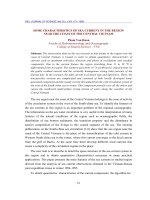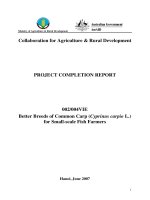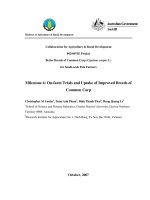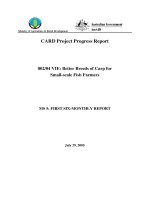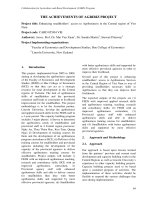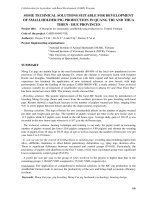Báo cáo nghiên cứu khoa học " SOME CHARACTERISTICS OF SEA CURRENT IN THE REGION NEAR THE COAST OF THE CENTRAL VIETNAM " doc
Bạn đang xem bản rút gọn của tài liệu. Xem và tải ngay bản đầy đủ của tài liệu tại đây (213.96 KB, 6 trang )
VNU. JOURNAL OF SCIENCE, Nat. Sci., t.XIV, n
o
3 - 1998
SOME CHARACTERISTICS OF SEA CURRENT IN THE REGION
NEAR THE COAST OF THE CENTRAL VIETNAM
Pham Van Huan
Faculty of Hydrometeorology and Oceanography
College of Natural Sciences – VNU
Abstract: The observation data on the sea currents at four points in the region near the
coast of Central Vietnam is treated in order to obtain quantitative characteristics of
currents such as maximum velocities, direction and phase of oscillations and residual
components. Due to the current feature the region stretching from 11 to 18
o
N is
differentiated into two parts. The northern part from 16
o
N northward is characteristic by
the gentle residual current and the vertically homogenous strong tidal currents of the
diurnal type. In the rest part, the tidal current is of mixed type and light force. There, the
non-periodic currents are complicated and consisted of both locally developed wind-
generated component and the steady current descended from the cold circulation system of
the west of the South-china sea in winter. This component prevails over all the others and
causes the southward undersurface strong stream of water along the coastline of the
Central Vietnam.
The sea region near the coast of the Central Vietnam belongs to the zone of activity
of the circulation system in the west of the South-china sea. To identify the features of
the sea currents in this region is an important problem of the regional oceanography.
The information on the sea water circulation is very useful in the interpretation of many
features of the natural conditions of the region such as oceanographic fields, the
distribution of sea bottom sediments, the transition property and the abundance in
species composition of the livings in this coastal segment of the sea. The existing
publications on the South-china sea circulation [1-6] show that the sea region near the
coast of the Central Vietnam is the place of the intensification of the cold current in
Western South-china sea in the winter, where this current converges to the local current
from the gulf of Bacbo. At the same time there develop different wind currents that
create a complicity of the circulation regime in the place.
The next task is to describe in detail the space structure of the sea current system in
this region and to obtain quantitative characteristics necessary in many practical
applications. This paper presents the main features of the sea currents in studied region
derived from the analysis of sea current observations obtained in the Vietnam-Russia
joint expedition cruise in winter 1994-1995.
To obtain quantitative characteristics of the current components the algorithm for
21
22 Pham Van Huan
the principal component analysis was applied to the observation series (table 1). For the
current series with observation length of four days and more the harmonic analysis by
least square method has been used to compute the harmonic constants of the tidal
constituents (tables 2 and 3).
Upon the basis of obtained quantitative characteristics of the currents we can make
the following generalized remarks on the regime of sea currents in the considered
region.
In the northern part of the studied region represented by the measured point of
17
o
38’N latitude and 107
o
01’E longitude the purely diurnal tidal current dominates. For
all thickness of the water the great axes of the tidal ellipses of diurnal component and of
semi-diurnal one have the direction northwest–southeast, i.e., the direction paralleled to
the shoreline. The magnitude of the diurnal component takes the lead of the semi-
diurnal one. The revolving of the tidal current is observed for the semi-diurnal
component, but this component is of the magnitude insignificant in comparison with the
diurnal component. There is shown the identity of the maximum current direction and
the phase of oscillation at all horizons from the surface to the bottom. The maximum
diurnal tidal currents for three horizons are almost simultaneously southeastward at 0
o’clock and northwestward at 12 o’clock of conventional time. The phase lag between
horizons is about 0.1 hours only. The same picture is observed for the semi-diurnal tidal
components. The residual currents at the horizons from 20 m down to the bottom are
characterized by small speed about 13 cm/s and have the east direction and turn left
with the increasing of the depth. This is a sign of wind current that is generated in
friction shallow water domains.
The region from 16
o
18’N to 16
o
40’N more clearly presents the revolving
property of the tidal currents of the deep open sea. The tidal current has a speed much
less than that in the northern part. Moreover, the magnitudes of diurnal and semi-diurnal
currents have no much different values. The left turn of the current speed vector with
the depth increase is expressed clearly both in diurnal and in semi-diurnal components.
An irregularity is observed for the observation point 108
o
41’E-16
o
18’N: the phase lag
between horizons 30 m and 60 m appears to be complex – the phases of oscillation at
two these horizons are almost opposed. Because of the lack of observations for the
horizon 60 m at point 109
o
00’E-16
o
40’N this irregularity can not be checked.
The residual currents at the horizons near to the surface are very weak, just about
10 cm/s speed and its speed decreases rapidly with the depth. Certainly, these are
currents caused by local wind. At the same time at the horizon 60 m in the observation
point 108
o
41’E-16
o
18’N observed a strong residual current with speed value greater 40
cm/s. Most likely this the current component of the steady winter current system of
north-south direction because this horizon is coincide with the depth of the steam jet of
steady winter currents system in the west part of the South-china sea. The southern part
of the studied region represented by the measured point of 11
o
00’N latitude and
109
o
10’E longitude is characterized with a regime of tidal currents of mixed type and
gentle strengthen. The diurnal current is less than 20 cm/s and the semi-diurnal current
is less than 10 cm/s. Again, there reverse tidal currents typical to near-shore shallow
Some Characteristics of Sea Current in the . . . 23
waters takes the lead. With the depth increasing, a right turn of the diurnal and semi-
diurnal currents is observed and a phase lag equals about one hour for 10 m depth
increase in the case of the diurnal tidal current. The residual current in this region is
comparatively impressive. At horizon 10 m the speed reaches 60 cm/s and more, at
horizon 60 m it equals 35 cm/s also and at horizon 90 m it decreases rapidly down to 13
cm/s. This place is situated in the last segment of the west South-china sea steady
current system where the stream jet tends to rise toward sea surface and the residual
currents at the near-surface horizons are much stronger than that of the lower horizons.
It is obvious that the origin of the current is not local winds since at relatively deep
horizons bellow the sea surface there observed great speed still.
Table 1. Characteristics of currents in sea region of the Central Vietnam
Diurnal component Semi-diurnal component Residual current
Longitude
and
latitude
Horizon
(m)
Speed
(cm/s)
Direction
(
o
)
Phase
(hour)
Speed
(cm/s)
Direction
(
o
)
Phase
(hour)
Speed
(cm/s)
Direction
(
o
)
107
o
01’E 20 46 143 0.1 7 156 6.1 13 108
17
o
38’N 323 12.1 336 0.1
30 47 147 23.6 7 152 6.2 13 97
327 11.6 332 0.2
40 38 147 23.5 8 138 6.0 13 84
327 11.5 318 0.0
109
o
00’E 10 14 119 11.2 12 126 2.3 8 155
16
o
40’N 229 23.2 306 8.3
30 24 101 11.1 12 102 2.5 4 53
281 23.1 282 8.5
108
o
41’E 30 30 149 16.1 8 170 8.0 13 171
16
o
18’N 329 4.1 350 2.0
60 39 131 3.2 18 44 6.4 44 182
311 15.2 224 0.4
109
o
10’E 10 15 100 7.5 8 102 5.4 63 278
11
o
00’N 280 19.5 282 11.4
30 10 153 9.2 3 124 4.3 55 195
333 21.2 304 10.3
60 9 17 1.2 6 175 6.0 35 197
197 13.2 355 0.0
90 20 22 3.5 6 193 5.6 13 210
202 15.5 13 11.6
Hence, the sea region near the coast of the Central Vietnam can be divided into two
parts with differentiated features of sea currents. In the northern part which stretches
from the parallel 16
o
N northward and belongs to the opening of the Bacbo gulf the
steady currents develop relatively weak but the tidal currents, especially the diurnal tidal
24 Pham Van Huan
component, have great magnitude and homogeneity in all water thickness. In the second
part composed of middle and southern part of studied region the circulation structure is
more complicate. There exist wind currents, steady current and tidal currents. The tidal
currents are of the weak speed and mixed type. The depth homogeneity of the tidal
currents does not express clearly and this shows the tide is a result of tidal waves
coming from different directions and they have a complex interaction as known for the
case of the tidal oscillation of water level. Since this region is under the influence of the
cold current system in the west of the South-china sea the steady current has a
dominance among all other components.
Table 2. Harmonic constants of observation point 109
o
00’E-16
o
40’N
(above line – amplitude cm/s, bellow line – phase
o
)
Tidal constituents
Com-
ponent
Resi-
dual
2
M
2
S
2
N
2
K
1
K
1
O
1
P
1
Q
4
M
4
MS
6
M
Horizon 10 m
Meri- -8 4 2 1 1 16 17 5 4 0 1 0
dional 274 225 274 225 32 321 32 321 197 294 148
Latitu- 0 6 2 1 1 24 23 8 5 0 0 0
dial 60 45 60 45 166 91 166 91 333 214 119
Horizon 30 m
Meri- 4 1 3 0 1 8 9 3 2 2 1 0
dional 284 225 284 225 25 297 25 297 317 27 68
Latitu- 4 8 10 2 3 34 23 11 5 3 4 1
dial 17 45 17 45 167 94 167 94 103 140 288
All above remarks once again confirm the general picture of sea current system of
the coastal zone that stretches from latitude 11
o
to 18
o
N and covers an important
segment of the sea shore of our country. The northern part, i.e., from 16 to 18
o
N, is a
place of meeting of the two currents of the South-china sea: the west Bacbo gulf long-
shore current and the winter cyclonic current of west South-china sea. The first current
takes the start from the Bacbo gulf and follows its west shoreline southeastward.
Originating in a small and shallow water body as Bacbo gulf and reaching the southwest
opening of this gulf with the increased depth, certainly this current can not develop to a
strong stream. In fact, the southeastward current measured at Bacbo gulf opening was of
about ten cm/s speed for horizon 20 m. The second current has a longer travel: it comes
from the northeast from the South-china shelf across the exposed domain off the Bacbo
gulf opening, so it has a larger scale and a greater intensity. Meeting off shore of the
north of the Central Vietnam either winter current of west South-china sea encroaches
the west Bacbo gulf current or two currents associate to one flow and continue to follow
Some Characteristics of Sea Current in the . . . 25
southward along the shore of the Central Vietnam. On this continue travel, since the
flow follows closely to the shore and since the winter northeast monsoon field is
favorable to development the flow becomes more intensive and due to the deepness of
this coastal zone the flow can develop not only near the surface but mainly in lower
horizons some tens meters bellow. At the observation points on the way of this flow the
velocity of non-periodic surface currents was small, but for the deeper horizons it is
relatively great. Reaching the threshold of the southwest shelf of the South-china sea,
the flow tends both to continue follow the shoreline and to rise toward the surface
turning left along the outer edge of the shelf. In all probability here or some where
southward no far from here is the place of the activity end of the winter current system
of the west South-china sea.
Table 3. Harmonic constants of observation point 108
o
41’E-16
o
18’N
(above line – amplitude cm/s, bellow line – phase
o
)
Tidal constituents
Com-
ponent
Resi-
dual
2
M
2
S
2
N
2
K
1
K
1
O
1
P
1
Q
4
M
4
MS
6
M
Horizon 30 m
Meri- -14 5 2 1 1 20 15 7 3 5 3 1
dional 68 45 68 45 67 344 67 344 9 77 171
Latitu- 0 7 7 1 2 23 26 8 5 5 3 1
dial 237 225 237 225 252 170 252 170 148 227 339
The existence of the sea current, which has the shape of a narrow stream, closely
follow the shoreline and bringing water from different places to sea region surrounding
the shore of our country, forms a well-developed hydrological front zone with great
gradient of oceanographic characteristics in the studied region. The space structure of
the fields of temperature and salinity and other elements of sea water in this region
shows a close agree with the above described dynamic picture.
The transfer of water by the current from higher latitudes to the tropical sea in the
steady northeast monsoons certainly is the season of many other processes of this sea
region not only in the winter but also in all time of the year. The problem of
investigation on the changes of marine conditions of west part of the South-china sea
and possibly the climate of our country as well and their prediction depends much on
what we know about this sea current system.
This work is a result of the theme 7.8.11 “The system of currents in the west of
South-china sea and its impact on the natural conditions of Vietnam coastal” (Basic
Research Program, The Earth Sciences 1996-1997).
26 Pham Van Huan
REFERENCES
1. P. Chevey, P. Carton. Les courants de la Mer de Chine – Meridionale et leurs
repports avec le climat de l’ Indochine. Note de l’ IODI26e (1939).
2. Hoàng Xuân Nhuận. Phân tích gián tiếp trường dòng chảy tại vùng biển khơi Trung
Bộ. Tuyển tập Nghiên cứu biển I-2. Nha Trang 1979, tr. 43-62.
3. Хоанг Суан Ньуан. Основные черты трехмерной циркуляции вод Южно-Китайского
моря в периоды устойчивых муссонов. Диссертация на соискание ученой степени.
кандидата Физико-математических Наук. Л., 1982, ст. 145.
4. Trần Sâm, Võ Văn Lành, Bùi Hồng Long. Tập bản đồ trung bình các yếu tố vật lý thủy văn
và động lực biển Đông. Tuyển tập báo cáo khoa học. Hội nghị Khoa học toàn quốc về biển
lần thứ 3,
tập II, Hà Nội, 1991, tr. 96-100.
5. M. Uda, T. Nakao. Water masses and currents in the South-china sea and the seasonal
changes. The Curoshio III-Proc. of the Third CKS Symposium. Bangkok, 1973
6. K. Wyrtki. Physical Oceanography of the Southeast Asian Waters. NAGA Report, vol. 2, La
Jolla, California, 1961.
TẠP CHÍ KHOA HỌC ĐHQGHN, KHTN, t.XIV, n
o
3 – 1998
MỘT SỐ ĐẶC TRƯNG DÒNG CHẢY Ở VÙNG BIỂN GẦN BỜ MIỀN TRUNG
Phạm Văn Huấn
Khoa Khí tượng Thủy văn và Hải dương học
Đại học KH Tự nhiên – ĐHQG Hà Nội
Đã xử lý những số liệu quan trắc về dòng biển tại bốn điểm trong vùng biển gần bờ
miền Trung Việt Nam để nhận những đặc trưng định lượng của dòng chảy như tốc độ
và hướng của các dòng cực đại, pha dao động của dòng chảy, các dòng dư…
Theo những đặc trưng của dòng chảy, vùng biển dọc bờ miền Trung từ vĩ độ 11
đến 10
o
N phân hóa thành hai phần. Phần phía bắc vĩ tuyến 16
o
N đặc trưng bởi dư lưu
tương đối yếu và các dòng triều toàn nhật mạnh đồng nhất theo phương thẳng đứng.
Phần thứ hai còn lại dòng chảy triều thuộc loại hỗn hợp với cường độ yếu. Trong phần
này các dòng chảy phi tuần hoàn tỏ ra phức tạp và bao gồm cả thành phần dòng chảy do
gió hình thành tại chỗ lẫn thành phần dòng chảy ổn định có nguồn gốc từ hệ thống dòng
biển lạnh tây biển Đông trong mùa đông. Dòng này có cường độ áp đảo so với tất cả các
dòng khác và hình thành luồng nước mạnh dưới mặt hướng xuống phía nam dọc theo bờ
biển miền Trung Việt Nam.
